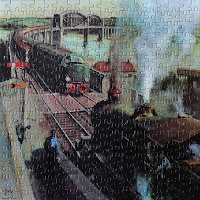Today's post, 30th April 2013, comprises two pictures of jigsaw puzzles featuring major railway stations in London, in steam days naturally.
 The first shows a 150-piece wooden jigsaw puzzle titled St Pancras, part of a 'GLEVUM' SERIES of puzzles. According to the Glevum Games website "Glevum Games was the principle trade name used by a firm established in Gloucester in 1894 by Harry Owen Roberts and his younger brother John Owen Roberts. Roberts Bros manufactured a vast range of products at their factory in Upton Street, Gloucester. The factory was built in 1902 and provided state-of-the-art workplace for the worforce of up to about 700 employees........". The company manufactured a huge range toys and games and some of the latter are often available on Ebay. A book about the company was published in 2003. The St Pancras jigsaw puzzle features several Midland 'Compound', 4-4-0 steam locomotives designed originally by Samuel Waite Johnson and updated by Richard Deeley. The locomotives/trains are static in the station with passengers and station staff prominent also.
The first shows a 150-piece wooden jigsaw puzzle titled St Pancras, part of a 'GLEVUM' SERIES of puzzles. According to the Glevum Games website "Glevum Games was the principle trade name used by a firm established in Gloucester in 1894 by Harry Owen Roberts and his younger brother John Owen Roberts. Roberts Bros manufactured a vast range of products at their factory in Upton Street, Gloucester. The factory was built in 1902 and provided state-of-the-art workplace for the worforce of up to about 700 employees........". The company manufactured a huge range toys and games and some of the latter are often available on Ebay. A book about the company was published in 2003. The St Pancras jigsaw puzzle features several Midland 'Compound', 4-4-0 steam locomotives designed originally by Samuel Waite Johnson and updated by Richard Deeley. The locomotives/trains are static in the station with passengers and station staff prominent also.
The majestic St
Pancras Station was completed for the Midland Railway (MR) in 1868. The railway
had secured an Act of Parliament for the station five years previously - the
site was adjacent to the Great Northern Railway’s Kings Cross Station. Before
the new station was built the MR was using other London stations, particularly
Euston, but had built its own London line from Bedford for the opening of St
Pancras; the MR had become disillusioned with constant delays on lines into
Euston. The 243ft span was exceptional for an interior and covered the
magnificent trainshed of engineer William Barlow - the world’s largest enclosed
space.
 The second picture shows a 500-piece jigsaw from Waddingtons titled Waterloo Station. Helen Madeleine McKie painted two posters for the Southern Railway in 1948 to commemorate the Centenary of the opening of the rebuilt Waterloo Station. Britain in the grip of war is contrasted with the station in peacetime in the two posters. The posters show hundreds of busy passengers in exactly the same positions and poses in each, but with clothing and roles changed to match the time. The distinction between red tunics and khaki uniforms of the guardsmen in both posters is particularly interesting as is the wartime camouflage and post war decor of the station. The jigsaw replicates the peacetime poster.
The second picture shows a 500-piece jigsaw from Waddingtons titled Waterloo Station. Helen Madeleine McKie painted two posters for the Southern Railway in 1948 to commemorate the Centenary of the opening of the rebuilt Waterloo Station. Britain in the grip of war is contrasted with the station in peacetime in the two posters. The posters show hundreds of busy passengers in exactly the same positions and poses in each, but with clothing and roles changed to match the time. The distinction between red tunics and khaki uniforms of the guardsmen in both posters is particularly interesting as is the wartime camouflage and post war decor of the station. The jigsaw replicates the peacetime poster.
Waterloo Station
was opened by the London & South Western Railway in 1848 as Waterloo Bridge Station comprising just
four platforms and six tracks. It was built on an extension from Nine Elms Station which was the L&SWR London terminus. The station was extended in 1860, 1878 and 1885. In 1886 it was named Waterloo Station but the three earlier extensions had ceated total chaos for passengers resulting from eighteen platforms and only ten platform numbers. The
terminus was completely rebuilt by the same railway company between 1900 and
1922 into a new, twenty-one platform station, opened by Queen Mary on 21st March 1922.


